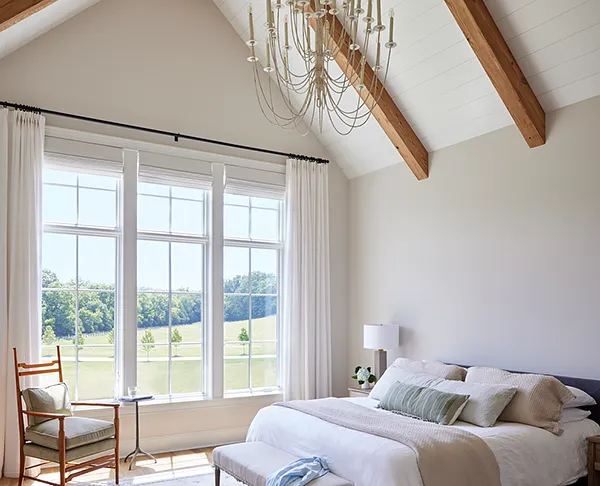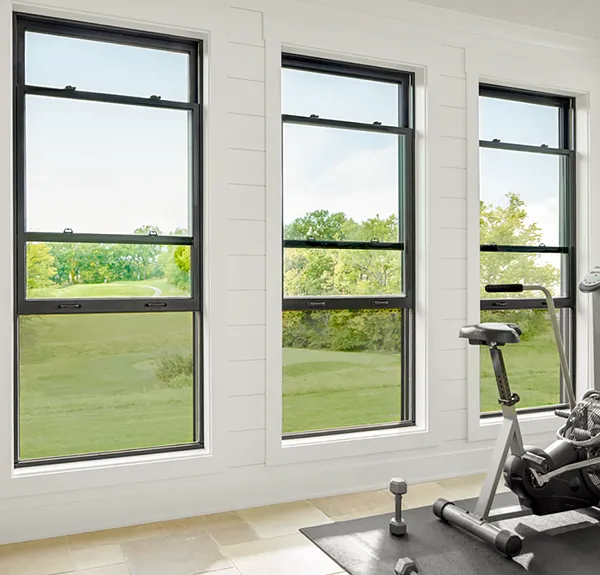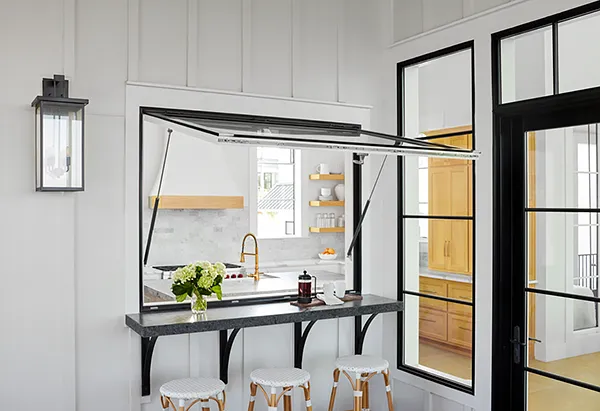Framing Your View: A Guide to Window Types & Features
by Rachel Lyon, Editorial Director for Direct from the Designers™
So, you’re looking for a new house to build or perhaps want to update the home you already have—do you know just how large an effect the windows you choose have on the overall picture? Style should be taken into account, of course, but you should consider practical requirements as well. Arm yourself with the right vocabulary to make sure you can communicate your wants and needs when shopping for windows for your home!

Windows That Swing Open
Many windows swing open with hinges on one side of the frame. The types that fall into this category are popular for brighter modern designs and address lighting concerns in tricky spaces. Hinged windows are also a good choice for easy operation, in case you or somebody in your household has difficulty moving sash-type panes. If you’re interested in swinging windows, the different kinds include:
Casement – One of the most popular windows by far, the casement variety comes in many flavors. All have hinges on the left or right side and are taller than they are wide. Unless otherwise noted, casement windows open out and you use a crank to operate them. You’ll also find push-out and inswing varieties, and even double configurations that open like French doors for larger apertures.
Awning – Most often used in tandem with large windows or in basement applications, awning windows have hinges on the top edge and swing out. They are small, wider than they are tall, and make a great choice for daylighting below-ground rooms. For many, the main purpose of awning windows is to provide ventilation.
Hopper – The awning window’s cousin, the hopper looks similar but has hinges on the bottom edge and swings inside. It is used for many of the same reasons, but tends to be favored in bathrooms. If you like to have windows open when it’s raining, the hopper is not a good choice because it can channel water inside. This is also considered a more niche window type and is often only available as a custom product.
Homeowners looking for a good all-around window will likely find it in this category. Hinged windows are also great in terms of performance, especially if you want to build an energy-efficient home, because they don’t need flexible seals to operate. They tend to come out ahead of sliding models in terms of airtightness, so consider these if you’re looking for a tighter building envelope for those more inclement seasons and still want to enjoy a natural breeze on nicer days.

Windows That Slide Open
On the other side, we have windows that stay within their frames when opened. The sliding variety is the best choice if you don’t want to worry about clearance. Bushes, furniture, walkways, and people are all potentially hazardous to a swinging window—and could find such windows hazardous themselves—and could limit how much you can actually open them. If you’re interested in sliding windows, the major types are:
Single Hung – This popular style describes windows with two distinct components: a fixed sash and a moving sash. The top portion of the window is the one usually fixed in place and the bottom pane can slide up over it, thus creating an opening and letting in the breeze.
Double Hung – With two moving sashes, double hung windows are ideal for creating air flow and offer lots of flexibility. The sashes can be moved up and down to your liking. In the past, these windows were favored because, when both panes were moved to the middle of the frame, heat could escape through the top while cooler air was drawn inside through the bottom opening. Consider double hung windows the climate control of the colonial period!
Slider/Glider – Think of this side-to-side sliding variety sort of like a patio door. These windows are suited to places where you want an opening window that is wider than it is tall. They fill a niche that makes them most popular for modern homes, but there are lots of finishing options that can dress them up for classic styles, too.
Sliding windows, especially those with up and down motion, have a lot of history and tend to be favored for old-fashioned architecture. Colonial homes, farmhouses, Craftsman designs, and many European styles have distinctive hung windows, so you can understand why they remain prevalent in new construction of these historical favorites.

Other Window Terminology
You’ll find there are plenty of features and variables to consider on your window search. If you’re looking for something more specific to describe what you want, here is some of the most common lexicon you might encounter:
Fixed/Picture – Non-operable windows are described as fixed because they don't move. They are also called picture windows because that's their main purpose—to frame views like a picture. This window type comes in all shapes and sizes, is the most energy efficient of them all, and is often used in conjunction with operable windows for ventilation and emergency egress.
Bay and Bow – These terms describe a window arrangement that pushes out from a wall, like you might expect in a sunny eating nook or sitting area. The type of windows used could be fixed, casement, single hung, or double hung, depending on your needs. Bay window designs have three distinct sides while bow windows follow a smooth arc.
Divided Lites – Smaller panes of glass held together by wooden muntins create divided lites. This was a method to build larger windows when glass was very difficult to make, and the style remains popular for homes with historical exterior designs.
Simulated Divided Lites (SDLs) – Windows that have wood bars adhered over large glass panes to mimic the historical aesthetic. They are less expensive and more energy efficient than true divided lites, and are available in a number of patterns to produce the right feel for the home. There are also removable grilles if you want lites and still want to be able to clean your windows well.
Grilles-Between-the-Glass (GBGs) – Windows with divided lite looks, but the grilles are permanently sealed between the inner and outer panes of glass. You can clean them as easily as windows without any grilles.
Polygon/Special Shape – Fixed windows available in a variety of shapes. Imagine a triangular window under a sloped ceiling or an octagonal window used to capture a natural view. Angled window shapes are often used in contemporary architecture while round and arched ones are favored for traditional applications.
Tilting – Sometimes for everyday operation and sometimes just for cleaning, a number of window models have a tilting feature that tips the sash inside like a hopper. There are hung windows that can tilt as well as slide, and even some casement windows that have swinging and tilting operation! Be sure to ask about each window you look at if you’re serious about having clean windows and want the tilting feature for easy access.
Window Opening Control Devices (WOCDs) – A safety feature that all families should consider. WOCDs limit the amount that a window can open to prevent children from falling out of it. Each type of window requires a different kind of device, but most are small enough to go unnoticed, and they can be disengaged by an adult to allow windows to open fully.
If you’re looking for some amazing windows to complete your home, check out the huge selection available from Pella®! They offer every kind of style you could want, and many more features than we could cover here. Whether you prioritize beauty, energy efficiency, or durability, you’ll find the perfect solution—and it probably encompasses all three of these traits anyway! Schedule a free consultation or find your local showroom to get started!
BROWSE HOME PRODUCT ARTICLES
- Creating a Spa-Like Master Bathroom »
- Designing a Water-Efficient Bathroom »
- Design a Modern Bathroom »
- View All Bathroom Articles »
- Building a New Home »
- Building a Duplex »
- Finding the Right Home Builder »
- View All Building Tips Articles »
- Adding the Right Columns»
- Decorative Touches for Your Interior»
- Shutters for Every Architectural Style »
- View All Columns & Millwork Articles »
- How to Use Specialty Laminates »
- Decorative Touches for Your Home's Interior
- View All Countertops and Surfaces Articles »
- What Goes Into a Great Deck? »
- Decorative Touches for Your Home's Interior »
- View All Decking Articles »
- Choosing Glass for Your Entry »
- Stylish Personas for Your Front Door »
- Using Sidelites and Transoms »
- View All Door Articles »
- Choose Siding for Your Region »
- Get the Most Out of Exterior Paint »
- Mixing Siding to Define Your Exterior »
- View All Exterior Articles »
- Finding the Right Home Builder »
- The Appeal of Small House Plans »
- Choosing the Perfect Floor Plan »
- View All Finding a Home Plan Articles »
- Colorful Flooring for Your Home »
- Designing With Different Widths»
- Chic, Neutral, Gray Flooring »
- View All Flooring Articles »
- Garage Doors That Add Curb Appeal »
- Caring for Your Garage Doors »
- Benefits of Insulated Garage Doors »
- View All Garage Door Articles »
- Reclaimed Products for Your Home »
- Building a Green and Stylish Home »
- Benefits of Building with SIPS »
- View All Green Building Articles »
- Cool Gadgets for Your New Home »
- Creating a Hi-Tech Home »
- Efficient Gifts for New Homeowners »
- View All Home Electronics Articles »
- Improve Your Home's Air Circulation »
- How to Improve the Air Circulation in Your Home »
- View All HVAC Articles »
- Bedrooms Designed for Sleep »
- Selecting a Fireplace for Your Home »
- Crafting a Luxurious Master Suite »
- View All Interior Design Articles »
- Design the Perfect Outdoor Space »
- Dive into a Beautiful Pool »
- Design a Sizzling Outdoor Kitchen »
- View All Outdoor Living Articles »
- Apps to Help You Pick Paint Colors »
- Create the Perfect Mood with Paint »
- How to Read the Color Wheel »
- View All Painting & Decorating Articles»
- Creating a Spa-Like Master Bathroom »
- High-Impact Kitchen Upgrades »
- Creating a Water Efficient Bathroom »
- View All Plumbing Fixtures Articles»
- Cladding That Complements Your Exterior »
- Reasons to Consider Prefinished Siding »
- View All Siding & Cladding Articles»
- All About Solar Powered Skylights »
- Natural Lighting for the Dark Corners of Your Home »
- Design a Better Bedroom with Skylights »
- View All Skylight Articles»
.png)
.png)
